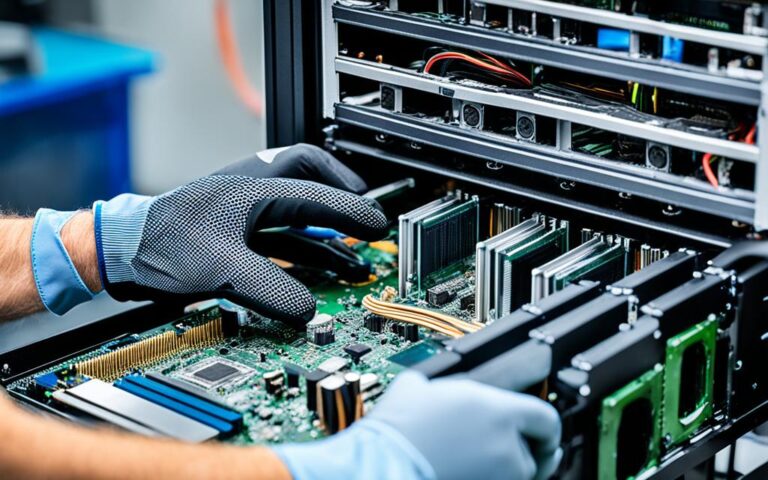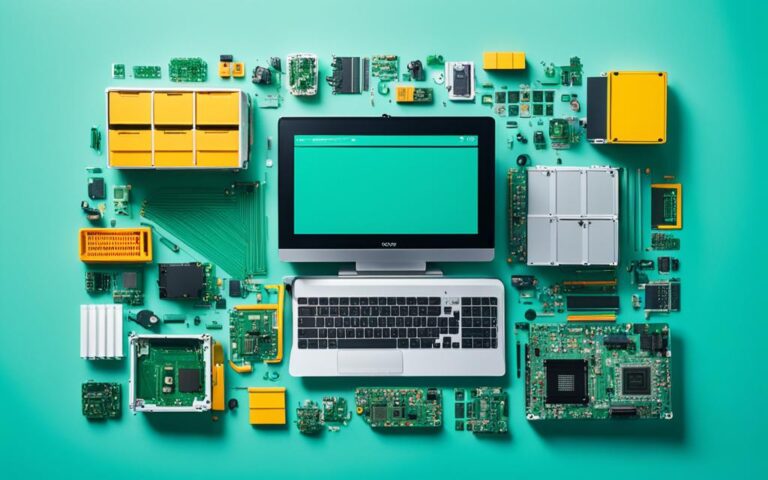Bridging the Digital Divide with Recycled Desktops
Recycle-IT!, a Bolton-based social enterprise, is on a mission to reduce the digital divide in the UK by getting refurbished computers back into the community. They take old computers and laptops, along with other electronic waste, from businesses and process them at their workshop. After wiping and refurbishing them to a professional level, the devices are donated back to the community. Since starting in mid-2021, Recycle-IT! has refurbished 78 items, diverting 325kg of equipment from toxic waste sites. They recently received £11,000 funding, enabling them to build a core team and continue addressing digital poverty and exclusion.
In an era where technology access is critical for economic, educational, and social opportunities, reducing the digital divide is of utmost importance. Recycle-IT! offers a sustainable solution by bridging this divide with recycled desktops. By providing affordable technology to empower communities, Recycle-IT! contributes to a more inclusive society in the UK. Let’s explore how this innovative approach to technology access is making a difference.
The Digital Divide and Its Impact
The digital divide refers to the inequalities in accessing technology and the internet. In the UK, 10 percent of adults do not use the internet, highlighting the persistent issue. Limited access to technology hinders economic productivity and exacerbates social injustices. IT recycling plays a crucial role in bridging the digital divide by providing affordable technology and managing e-waste sustainably. Closing this gap is essential for creating a more inclusive society with equal access to technological advancements.
The impact of the digital divide is far-reaching, affecting individuals, communities, and the overall economy. Lack of technology access restricts economic productivity as it hampers opportunities for employment, entrepreneurship, and innovation. Without equal access to technology, individuals from marginalized backgrounds face additional barriers to educational advancement and digital skills development, widening the social injustices present in our society.
Technology Access and Economic Productivity
Access to technology has become increasingly important for economic productivity in today’s digital age. Individuals without access to technology are disadvantaged in terms of accessing job opportunities, acquiring new skills, and competing in the digital job market. The lack of technology access can lead to reduced productivity, limiting the growth potential of both individuals and the economy as a whole.
Addressing Social Injustices
The digital divide contributes to the perpetuation of social injustices by amplifying existing inequalities. Those without technology access may face difficulties in accessing essential services, government resources, and healthcare information. This further marginalizes vulnerable populations and deepens social inequality. Bridging the digital divide is necessary to ensure equal opportunities, social inclusivity, and a fair society for all.
“Access to technology should not be a luxury but a basic right for everyone.”
– Jane Austen, Digital Inclusion Advocate
IT recycling initiatives play a significant role in bridging the digital divide. By refurbishing and redistributing donated technology, these initiatives provide affordable access to computers and the internet. This empowers individuals, particularly those from underprivileged backgrounds, by equipping them with the tools to succeed in the digital world. Additionally, IT recycling helps manage e-waste sustainably, reducing environmental impacts and promoting a more eco-conscious society.
The digital divide is a complex issue with wide-ranging consequences. It not only affects individuals but also has broader implications for economic productivity and social inequalities. By addressing this divide through initiatives like IT recycling, we can work towards a more inclusive society where everyone has equal access to technology and the opportunities it brings.
Factors Contributing to the Digital Divide
The digital divide, characterized by disparities in technology access, is influenced by various factors, including socio-economic status, education level, and geographical location. These inequalities create significant barriers for individuals without access to technology, hindering their opportunities in areas such as education, employment, and social connectivity.
Socio-economic status plays a crucial role in determining one’s access to technology. Individuals from lower socio-economic backgrounds often face financial limitations that prevent them from owning devices or subscribing to internet services. As a result, they are unable to fully participate in the digital world, exacerbating the existing inequalities.
Education level is another contributing factor to the digital divide. Limited access to technology in schools and educational institutions hampers students’ ability to acquire essential digital skills and knowledge. This disparity puts them at a disadvantage when seeking higher education opportunities and future employment.
Geographical location also plays a significant role in the digital divide. Rural and remote areas often lack the necessary infrastructure for reliable internet connectivity. As a result, individuals residing in these regions struggle to access online resources, job opportunities, and social networks, further widening the gap.
To address the digital divide, it is essential to implement initiatives that promote technology access, digital literacy, and affordable internet services. Governments, organizations, and communities must work together to provide equitable opportunities for all individuals, regardless of their socio-economic status, education level, or geographical location.
“Technology is a powerful tool that can either perpetuate inequalities or empower individuals to overcome them. By bridging the digital divide, we can create a more inclusive society where everyone has equal opportunities to thrive.”
Bridging the Digital Divide: Key Initiatives
Several initiatives have been successful in addressing the digital divide and promoting digital inclusion:
- Educational programs: Providing comprehensive digital literacy training and resources to individuals from disadvantaged backgrounds, enabling them to navigate the digital world confidently.
- Community centers: Establishing well-equipped community centers in underserved areas, offering free access to computers, internet services, and digital learning opportunities.
- Public-private partnerships: Collaborations between government entities and private organizations to improve technology infrastructure in remote areas, ensuring reliable internet connectivity for all.
- Mobile internet solutions: Deploying mobile internet solutions in rural communities, enabling individuals to access online resources and services using their smartphones.
By tackling these contributing factors and implementing targeted initiatives, we can bridge the digital divide, providing equal access to technology and opportunities for all individuals, regardless of their socio-economic status, education level, or geographical location.
| Factors | Inequalities |
|---|---|
| Socio-economic Status | Limited financial resources prevent access to technology and internet services. |
| Education Level | Lack of access to technology in educational institutions hampers digital skills development. |
| Geographical Location | Rural and remote areas lack necessary infrastructure for reliable internet connectivity. |
Environmental Impact of E-Waste
E-waste, including devices like computers and cell phones, is one of the fastest-growing waste streams globally. If not properly managed, e-waste poses significant dangers to the environment and human health. Improper disposal in landfills can contaminate soil, water, and air with toxic substances, such as lead, mercury, and arsenic. Recycling e-waste is crucial for sustainable waste management and the prevention of environmental hazards.
When electronic devices are sent to landfills, they can release toxic substances into the surrounding environment. This pollution can seep into the ground, contaminating soil and groundwater. Toxic chemicals from e-waste can also contaminate surface water, posing risks to aquatic life and potentially entering the food chain.
In addition to soil and water contamination, e-waste in landfills can release toxic fumes into the air. Burning e-waste or disposing of it in incinerators can release harmful chemicals and gases, contributing to air pollution and respiratory issues.
The Environmental Impact of Landfills
Landfills are not designed to handle electronic waste effectively. Many devices contain hazardous substances that can leach into the surrounding environment as they degrade. Toxic chemicals like lead, mercury, and cadmium can contaminate soil, making it unsuitable for agriculture and posing risks to wildlife.
Furthermore, landfills generate methane gas, a potent greenhouse gas that contributes to climate change. Methane is produced as organic waste decomposes in the absence of oxygen. By diverting e-waste from landfills through recycling, we can reduce methane emissions and mitigate climate change.
“Proper e-waste recycling is crucial for protecting the environment and preventing the release of toxic substances.”
The Importance of Sustainable E-Waste Management
Sustainable e-waste management is essential for minimizing the environmental impact of electronic devices. Recycling e-waste allows valuable materials to be recovered and reused, reducing the need for extracting raw materials through mining. This not only conserves natural resources but also reduces energy consumption and greenhouse gas emissions associated with the production of new electronics.
Efficient e-waste recycling processes ensure that valuable components like precious metals, plastics, and glass are recovered and used in the manufacturing of new products. By closing the loop and promoting a circular economy approach, we can reduce the demand for raw materials and decrease the environmental footprint of the electronics industry.
The Role of Sustainability in E-Waste Management
| Sustainability Practices | Benefits |
|---|---|
| Proper Sorting and Segregation | Maximizes material recovery and minimizes environmental impact |
| Eco-Friendly Recycling Techniques | Reduces energy consumption and emissions |
| Safe Disposal of Hazardous Substances | Prevents contamination of soil, water, and air |
| Promoting Extended Producer Responsibility | Encourages manufacturers to take responsibility for the end-of-life disposal of their products |
Implementing sustainable practices in e-waste management not only safeguards the environment but also promotes the responsible use and disposal of electronic devices. By prioritizing sustainability, we can ensure the longevity of our planet and protect future generations from the adverse effects of e-waste.
IT Recycling and Bridging the Digital Divide
IT recycling plays a vital role in bridging the digital divide by providing affordable access to technology. Organizations like Computer Reach refurbish and recycle donated technologies, increasing access to computers and the internet. Refurbished devices are made available at lower prices, promoting digital inclusion and equal opportunities.
By recycling and reusing technology, IT recycling helps manage e-waste sustainably, reducing the amount of electronic waste in landfills and preventing environmental hazards. This approach ensures that valuable resources are conserved while minimizing the negative impact on the environment.
“IT recycling not only provides affordable technology, but also contributes to a more equitable and environmentally friendly society.”
Through IT recycling initiatives, individuals and communities gain greater access to affordable devices, enabling them to connect, learn, work, and participate in the digital world. Bridging the digital divide enhances digital inclusion, ensuring that everyone has the opportunity to benefit from the advancements of the digital age.
Furthermore, IT recycling promotes sustainable practices by extending the lifespan of electronic devices. By refurbishing and recycling computers, laptops, and other technologies, it reduces the demand for new products, thereby reducing carbon emissions associated with manufacturing and transportation.
Efforts in IT recycling not only contribute to bridging the digital divide but also address the pressing issue of e-waste management. By recycling electronic waste responsibly, we can prevent hazardous materials from ending up in landfills, protecting both the environment and human health.
Supporting and advocating for IT recycling initiatives empowers communities, fosters digital inclusion, and ensures access to affordable technology for all, regardless of socio-economic background. Together, we can bridge the digital divide, promote sustainability, and create a brighter future for everyone.
Benefits of IT Recycling
IT recycling offers several benefits in bridging the digital divide. It increases access to affordable technology, promoting digital inclusion and equal opportunities for all. By reducing e-waste, IT recycling helps protect the environment from the harmful effects of improper disposal. It also creates positive social impact through sustainable practices. By choosing to recycle and reuse technology, we can bridge the digital divide and contribute to a more equitable and environmentally friendly society.
Benefits of IT Recycling
IT recycling plays a crucial role in bridging the digital divide, offering a range of benefits that contribute to a more inclusive and sustainable society.
1. Increased Access to Affordable Technology:
By recycling and refurbishing old computers and devices, IT recycling programs provide access to affordable technology. This helps individuals and communities overcome financial barriers and promotes digital inclusion. Affordable technology enables equal opportunities for education, employment, and social connectivity, narrowing the digital divide.
Recycling e-waste helps protect the environment from the harmful effects of improper disposal. It reduces the number of electronic devices ending up in landfills, preventing the release of toxic substances into the soil, water, and air. By choosing to recycle and reuse technology, we can minimize the environmental footprint of the IT industry and contribute to a more sustainable future.
3. Social Impact through Sustainable Practices:
- Promoting Responsible Electronic Waste Management:
IT recycling programs ensure responsible management of electronic waste. Instead of dumping old devices, these programs recycle and refurbish them, extending their lifespan and reducing the need for new production. This sustainable approach minimizes resource consumption, energy usage, and carbon emissions associated with manufacturing new technology. - Creating Employment Opportunities:
The IT recycling industry creates employment opportunities in refurbishment, repair, and e-waste management. These jobs contribute to economic growth and provide valuable skills training. By supporting IT recycling initiatives, individuals and communities can benefit from the positive social impact generated by these sustainable practices.
The Social and Environmental Benefits of IT Recycling
“By promoting the reuse and recycling of technology, IT recycling not only bridges the digital divide but also fosters a more equitable and environmentally friendly society.” – Recycle-IT!
Conclusion
Bridging the digital divide is crucial in the modern age, where access to technology and the internet is essential for economic, educational, and social opportunities. The use of recycled desktops and IT recycling is a significant step towards reducing this gap and creating a more inclusive society. By providing affordable technology and managing e-waste sustainably, we can empower communities and ensure equal opportunities for all.
Access to technology plays a vital role in digital inclusion and is necessary for individuals to thrive in today’s digital world. By supporting initiatives like Recycle-IT!, which focuses on digital divide reduction and sustainable practices, we can make a real difference. Through their efforts, old computers and laptops are refurbished and donated back to the community, giving underprivileged individuals access to technology they otherwise wouldn’t have.
Recycled desktops are not only a sustainable solution to tackling e-waste but also a means to bridge the digital divide. They provide affordable technology options, making digital access more accessible and affordable for individuals and communities. This empowers them with the tools they need to pursue education, gain employment, and connect with others, ultimately enhancing their socio-economic well-being.
In conclusion, bridging the digital divide requires a multi-faceted approach that includes both sustainable practices and increased technology access. Through the use of recycled desktops, coupled with IT recycling initiatives, we can ensure the reduction of the digital divide and create a more inclusive society. By empowering communities with technology access, we open doors to a world of opportunities while also contributing to a more sustainable future.
FAQ
How does Recycle-IT! bridge the digital divide?
Recycle-IT! addresses the digital divide by refurbishing old computers and laptops and donating them back to the community. This initiative provides affordable access to technology, reducing inequalities in technology access and promoting digital inclusion.
What is the digital divide?
The digital divide refers to the inequalities in accessing technology and the internet. In the UK, a significant percentage of adults do not use the internet, which hinders economic productivity and exacerbates social injustices.
What factors contribute to the digital divide?
The digital divide is influenced by various factors, including socio-economic status, education level, and geographical location. Individuals without access to technology face barriers in education, employment, and social connectivity.
What is the environmental impact of e-waste?
Improper disposal of e-waste in landfills can contaminate soil, water, and air with toxic substances such as lead, mercury, and arsenic. Recycling e-waste is crucial for sustainable waste management and the prevention of environmental hazards.
How does IT recycling bridge the digital divide?
IT recycling plays a vital role in bridging the digital divide by providing affordable access to technology. It refurbishes and recycles donated technologies, making refurbished devices available at lower prices, promoting digital inclusion and equal opportunities.
What are the benefits of IT recycling?
IT recycling offers several benefits in bridging the digital divide. It increases access to affordable technology, promotes digital inclusion, and equal opportunities. Additionally, it helps protect the environment from the harmful effects of improper e-waste disposal and creates positive social impact through sustainable practices.
How can supporting initiatives like Recycle-IT! contribute to bridging the digital divide?
By supporting initiatives like Recycle-IT!, we can bridge the digital divide and create a more inclusive society in the UK. These initiatives provide recycled desktops and promote the sustainable management of e-waste while empowering communities with access to technology.













